URBANIZATION
With the technological advancements our built environments grow in complexities and gain new and new layers of experience, new functions and new ingenuous solutions. Every city, every culture both brings something new to our over all experience and has their own unique particularities we have to take into account going about designing the spaces. In order to objectively notice what works and where we have to be able rigorously compare atomic elements of the cities we live in (streets, squares, urban fabrics, etc.); be able to glance over all possible varieties of the species we can encounter. Specifically in order to address this goal by a team led by Vicente Guallart, IAAC founder and former chief architect of Barcelona city – here in IAAC has been introduced the platform urbanization.org.
In particular, in this installment of the studio we have been exploring bigger scale elements of the cities as compared to streets in the previous period – urban fabrics. What is urban fabric? How many of them are there? What is the most common? What is the most comfortable? How do they compare? Our aim was to explore all possible urban fabrics of a city and compare them with each other as well as with other cities in the world.
Saint Petersburg
First of all, we narrowed in on a city we thought would be interesting to analyze in terms of variety and patterns of various fabrics over rich history the city went through – Saint Petersburg.
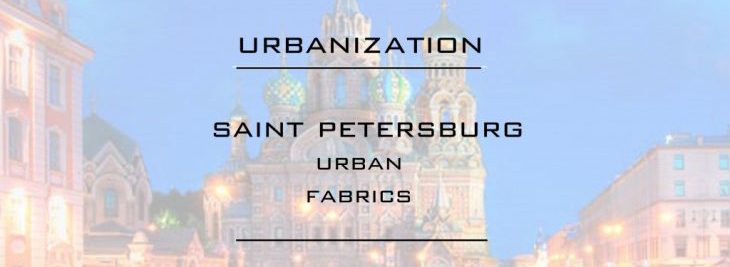
Urbanization // Saint Petersburg – Title
A short glimpse into history and statistics proven to be informative for the analysis.
The city is second biggest in Russia after Moscow and informally goes as a second capital of the country. Conversely, with population only around 4.8 million people and territory over 1496 squared kilometers, the city is uniquely not dense.
History
Historically the city was introduced as a strategic northern gate into the country. Its origin begins from the inspiration Russian tzar Peter the first got from the first in history visit to Europe and thus it bears resemblance in many of the features to European city though appropriated with time with Russian and Soviet realities. The city was one of the first completely stone built cities. In fact, at one point it was forbidden to build in stone elsewhere in the country in order to fast-track the development and ensure uniqueness of the city. Thus it rounds around a castle, has numerous channels in it’s historical part. Urban plans are clearly readable over-imposed on the landscape.
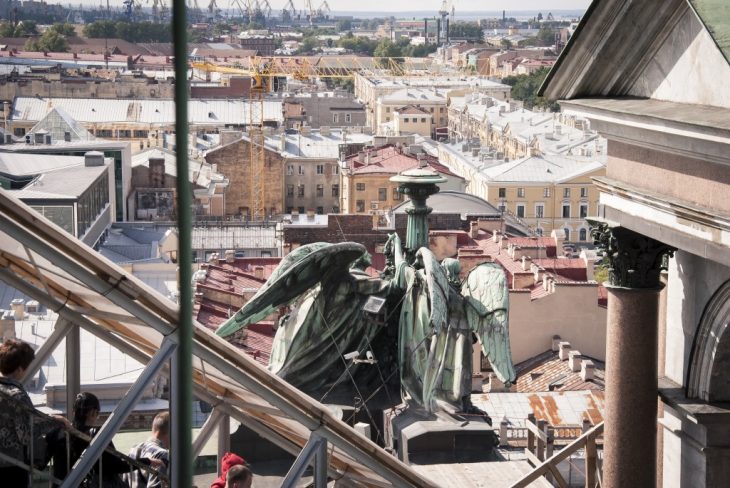
Urbanization // Saint Petersburg – Photo 1
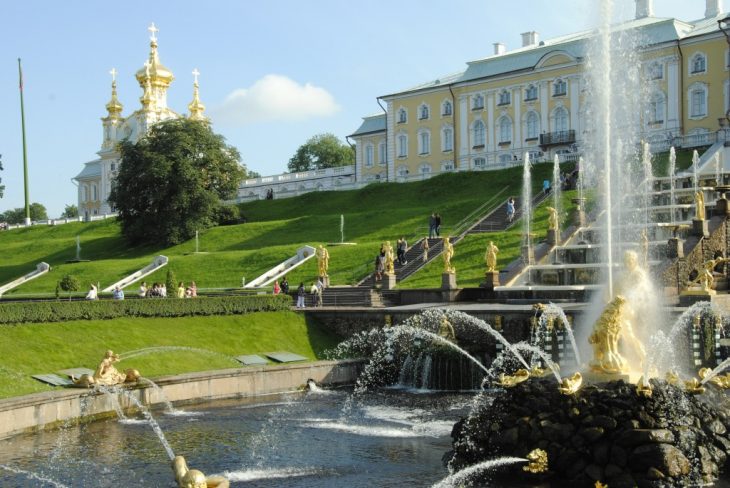
Urbanization // Saint Petersburg – Photo 2
Moreover, the city was named a capital immediately after inception before it was even fully developed. Lots of grandiose palaces and monuments had freedom to unveil not being constrained by usually tight historic surroundings a capital most commonly is associated with.
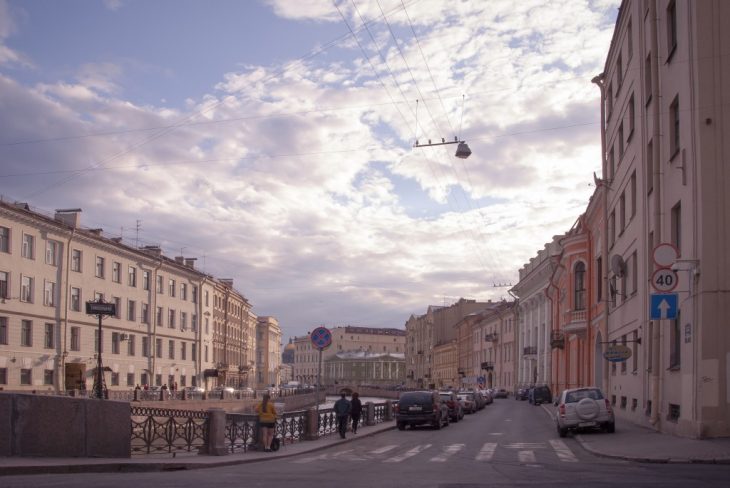
Urbanization // Saint Petersburg – Photo 3
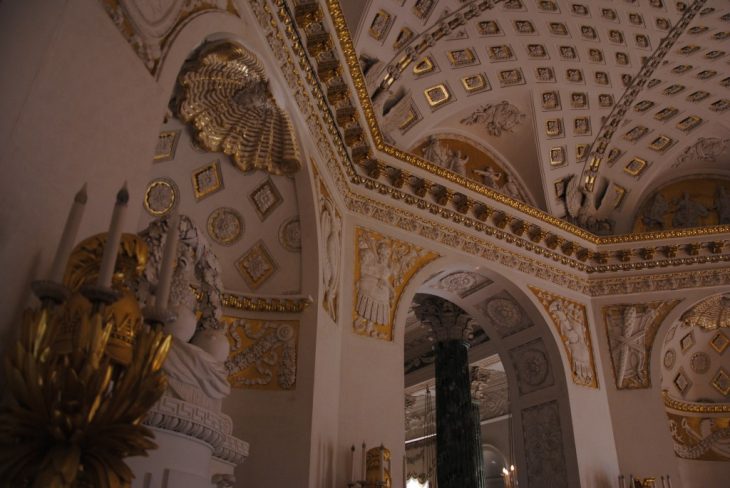
Urbanization // Saint Petersburg – Photo 4
Lastly the city is well known for its heroism as seen in the period of Second World War. Huge parts of the city were ruined. Thus, immediately after war lots of people were in need of housing. That has been resolved with a standardized solutions over vast areas in contrast to the character of the center.
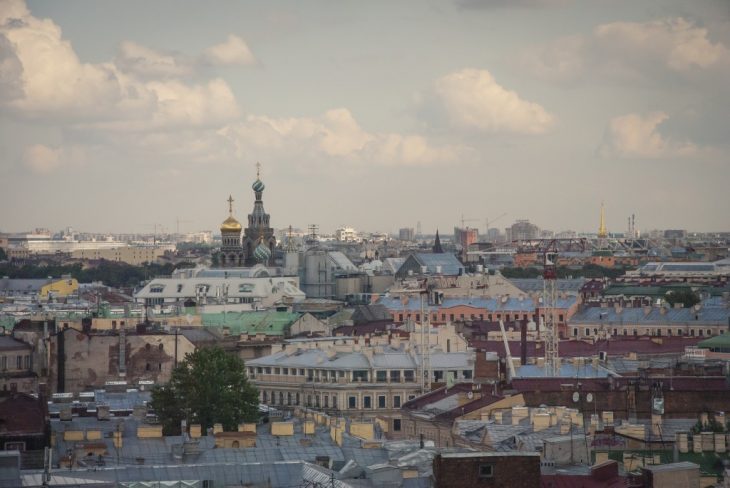 Urbanization // Saint Petersburg – Photo 5
Urbanization // Saint Petersburg – Photo 5
Connectivity
Also, initially the city was connected to the rest of the country only with water based routes. However, quickly the road was laid out. One of the first railroads was built to connect Moscow and Saint Petersburg. For this reason the city became defacto main industrial port. That got imprinted on the city introducing numerous purely industrial districts especially along the waterfront. What’s more you can see how the city is threaded with dead-end railroad stations coming from all sides to the city.

Urbanization // Saint Petersburg – Scheme (www.mappery.com)
Urban fabrics
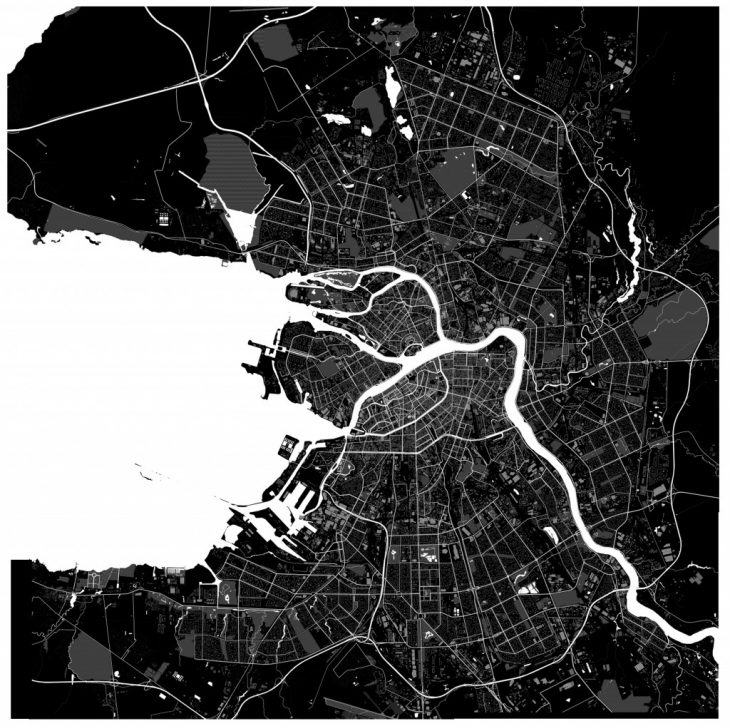
Urbanization // Saint Petersburg – Map
Let’s first get clear on what actually an urban fabric is. According to the definition, urban fabric is the physical aspect of urbanism, emphasizing building types, thoroughfares, open space, frontages, and streetscapes but excluding environmental, functional, economic and sociocultural aspects. In other words it is a relationship between the buildings, the streets, the public spaces and their properties maintained over an area.
Categorization
In order to distinguish one from another let’s introduce initial properties:
- Compactness:
- compact (alignment of buildings provides readable and noticeable system with respect to the scale);
- dispersed (more organic, less ordered structure-wise fabric with respect to the scale).
- Structure:
- site-specific (formed primarily over specificity of the landscape);
- hierarchical (following certain plan).
- Growth characteristic:
- grid (equally weighted subdivisions);
- super-grid (fractal patterns having additional structure on the bigger scale);
- linear grid (primarily following one readable axis);
- radial grid (primarily following radial structure);
- loose grid (combination of grids in a more or less systematic way);
- exponential (spontaneous often topographic and bottom up yet systematic);
- organic (un-ordered free-formed development).
- Building height:
- Low (<5 floors);
- Medium (6-12 floors);
- High (>15 floors).
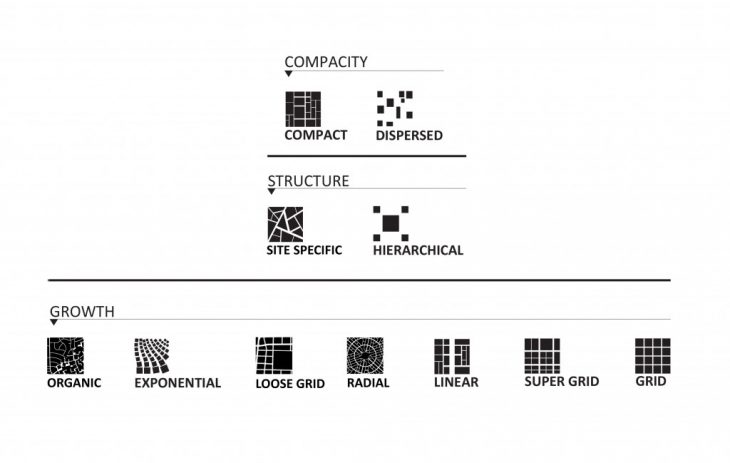
Urbanization // Saint Petersburg – Urban Fabrics Categories
Analysis
Even with these four properties one can get up to 84 potentially different fabrics. Of course, this list is not extensive enough to cover minute particularities of the cities but is a good base for initial distinctions and categorizations. As a result we discovered 19 fabrics in the city not fully correlating to the 18 administrative districts the city is divided into.
Result of the categorizations:
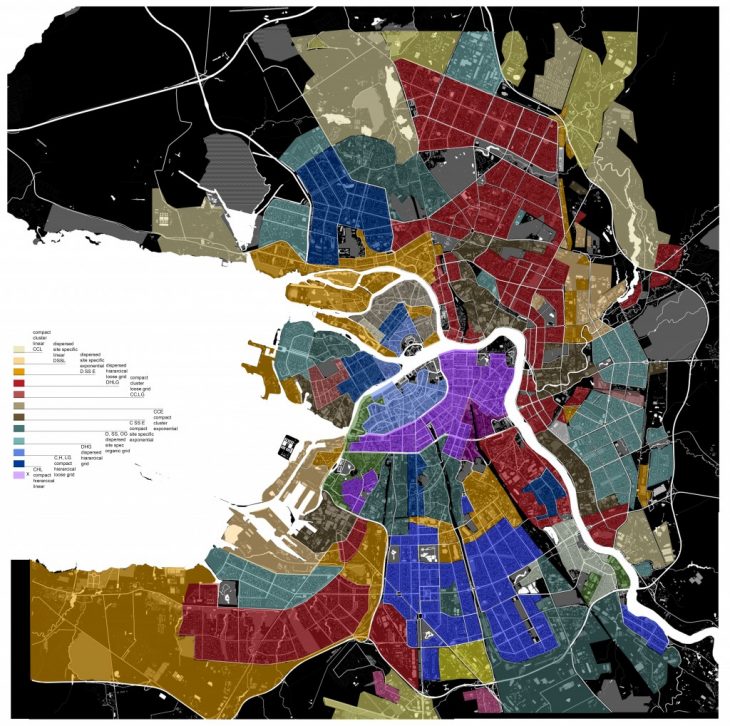
Urbanization // Saint Petersburg – Urban Fabrics Map

Urbanization // Saint Petersburg – Area distribution
As a result, the following 12 are the most common and deserve closer, more spatial attention:
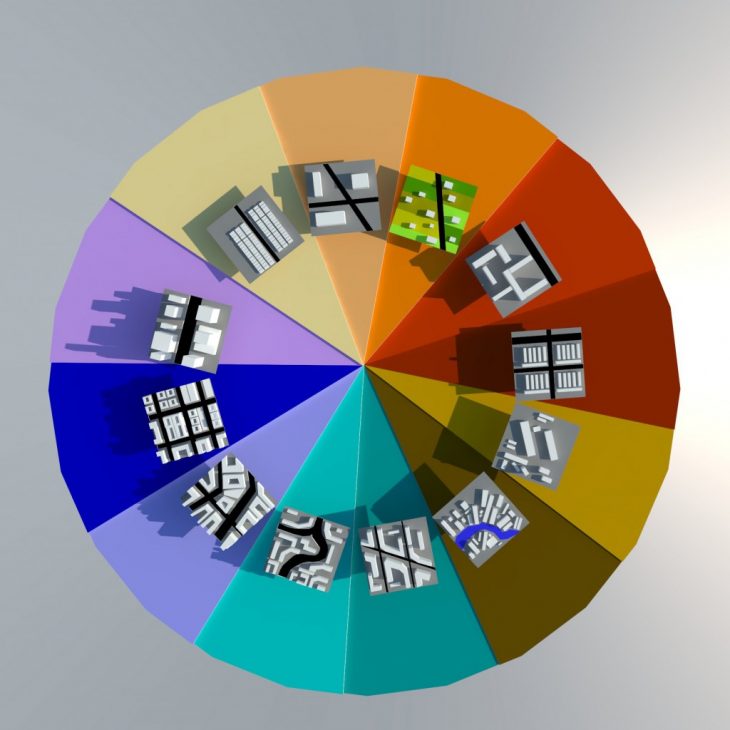
Urbanization // Saint Petersburg – Common Fabrics Color Wheel
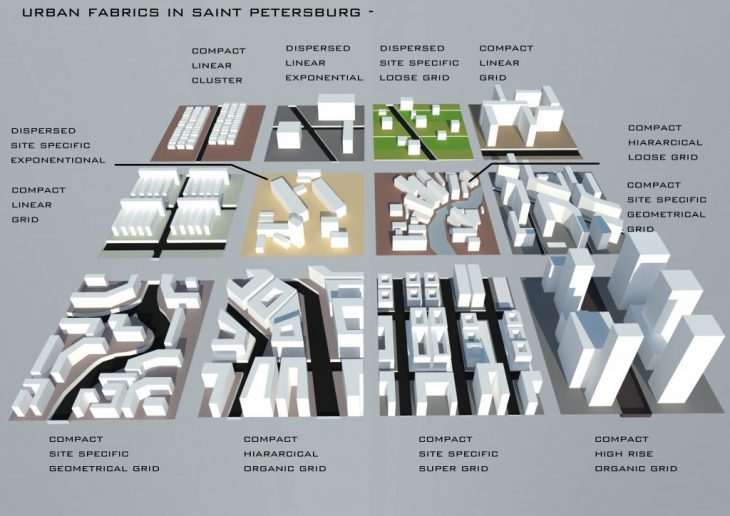
Urbanization // Saint Petersburg – Common Urban Fabrics
Conclusions
In conclusion, as you can see from areal distribution most common fabrics are dispersed. The distribution clearly follows radial historical pattern: representing years of prosperity when city had sufficient resources and was growing with supplementary industrial functions and years of growth with extensive purely residential area constructions – outlining rings. We can also notice expansive nature of growth. As well a subtle ideological conflict of strong center city closer to European model and aggrandizing equality of patches by socialist society the city went through. Additionally, unique property of being built from scratch resulted in great amount of stand-alone elements not fitting to any of the surrounding elements but having often unexpected influences on them.
Summary
To sum it all up, the anatomy of the cities is complex and intricate. One one hand, in the age of globalization and connectivity we have access to enormous amounts of information. On the other hand, from this sea of data now more than ever we need to focus on filtering and rigorous comparison in order to gain meaningful insights and proceed without making same mistakes and contradictions, that when it comes to urbanism can be costly and extremely time consuming. Knowing what makes existing cities tick thus is ever more relevant. In his context, described analysis aim to provide a seed for further enrichment of science of building cities.
_______________________________________________________________
SE.3 Urbanization.org // A project of IaaC, Institute for Advanced Architecture of Catalonia
Developed at Master in Advanced Architecture in 2018 by:
Students: Deepankar Pahuja, Daniil Koshelyuk, Francois Nour, Nikoleta Nikolova
Faculty: Honorata Grzesikowska
Advisor: Vicente Guallart
Urbanization.org – Platform for analysis and comparison of cities from around the world.